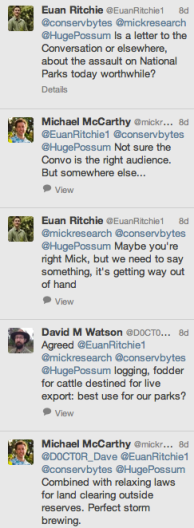 What makes some conservation endeavours successful where so many fail to protect biodiversity? Or, how long is a piece of string?
What makes some conservation endeavours successful where so many fail to protect biodiversity? Or, how long is a piece of string?
Yes, it’s a difficult question because it’s not just about the biology – such as resilience and area relationships – in fact, it’s probably more about the socio-economic setting that will ultimately dictate how the biodiversity in any particular area fares in response to disturbance.
In the case of protected areas (that I’ll just refer to as ‘reserves’ for the remainder of this post), there’s been a lot of work done about the things that make them ‘work’ (or not) in terms of biodiversity preservation. Yes, we can measure investment, how much the community supports and is involved with the reserve, how much emphasis is put on enforcement, the types of management done within (and outside) of the reserves, et cetera, et cetera. All of these things can (and have to some extent) been correlated with indices of the fate of the biodiversity within reserves, such as rates and patterns of deforestation, the amount of illegal hunting, and the survival probability of particular taxa.
But the problem with these indices is that there are just indices – they probably do not encapsulate the overall ‘health’ of the biodiversity within a reserve (be that trends in the overall abundance of organisms, the resilience of the community as a whole to future disturbances, or the combined phylogenetic diversity of the ecosystem). This is because there are few long-term monitoring programmes of sufficient taxonomic and temporal breadth to summarise these components of complex ecosystems (i.e., ecology is complex). It’s no real surprise, and even though we should put a lot more emphasis on targeted, efficient, long-term biodiversity monitoring inside and outside of all major biodiversity reserves, the cold, hard truth of it is that we’ll never manage to get the required systems in place. Humanity just doesn’t value it enough. Read the rest of this entry »



